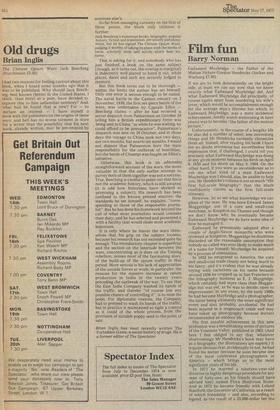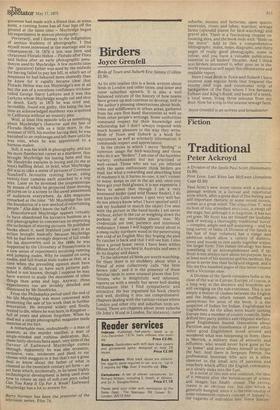Film fun
Barry Norman
Eadweard Muybridge the Father of the Motion Picture Gordon Hendricks (Secker and Warburg £7.50) If we are to look determinedly on the bright side, at least we can say now that we know exactly what Eadweard Muybridge did. And what Eadweard Muybridge did principally, of course (quite apart from murdering his wife's lover, which would be accomplishment enough for the average man's lifetime but which, to Eadweard Muybridge, was a mere incidental achievement, hardly worth mentioning in later years) was to become "the father of the motion picture."
Unfortunately, in the course of a lengthy life he also did a number of other, less interesting things and Mr Hendricks earnestly chronicles them all. Indeed, after reading his book I have the no doubt erroneous but nevertheless firm impression that, if challenged, I could tell you precisely what Eadweard Muybridge was doing at any given moment between his birth on April 9, 1830 and his death on May 8, 1904. On the other hand, if you were so inconsiderate as to ask me what kind of a man Eadweard Muybridge was I should, alas, be unable to help you. Mr Hendricks's volume is not so much "the first full-scale biography" that the blurb confidently claims as the first full-scale itinerary.
However, let us see what knowledge we can glean of the man. He was born Edward James Muggeridge, son of a Corn and small-coal merchant, in Kingston-on-Thames and though we don't know why he eventually became Eadweard Muybridge we do have some idea of how he managed it.
Eadweard he presumably adopted after a couple of Anglo-Saxon monarchs who were crowned at Kingston; Muggeridge he doubtless discarded on the reasonable assumption that nobody so-called was ever likely to make much of a name for himself; Muybridge he acquired by a process of elimination.
In 1852 he emigrated to America, the corn and small-coal trade clearly not being much to his fancy, and it's evident that he was already toying with variations on his name because around 1856 he cropped up in San Francisco in the lithography business as E. J. Muygridge, which certainly had more class than Muggeridge but was yet, as he was to decide, open to improvement.. In any event, by the early 1860s he had become Muybridge and a photographer, the latter being ultimately the more significant event and also, -probably, accidental. He had been injured in a stagecoach crash and may have taken up photography because doctors recommended an outdoor life.
His first notable achievement in this new profession was a breathtaking series of pictures of the Yosemite Valley, published in 1862. (And here I feel obliged to say that, whatever shortcomings Mr Hendricks's book may have as a biography, the illustrations are superb.) It is quite obvious that, accidentally or not, he had found his metier because he soon became one of the most celebrated photographers in America which brings us to the most significant years of his life. In 1871 he marrted a nineteen-year-old divorcee (a highly dangerons procedure for any man of forty-one, as his friends should have advised him) named Flora Shallcross Stone. And in 1872 he became friendly with Leland Stanford, the Governor of California, as a result of which friendship and also, according to legend, as the result of a 25,000-dollar bet the governor had made with a friend that, at some point, a running horse has all four legs off the ground at the same time — Muybridge began his experiments in motion photography. Perversely, and I daresay to the indignation of serious students of photography, I find myself more interested in the marriage and its consequences. In 1874 a son was born and christened Florado Helios — Florado after Flora and Helios after an early photographic pseudonym used by Muybridge. A few months later the (putative) father was sued by the midwife for having failed to pay her bill, in which act of meanness he had behaved more shrewdly than he knew for it rapidly became clear .that Florado Helios was not Muybridge's son at all but the son of a notorious confidence trickster called George Harry Larkyns and it was this Larkyns whom Muybridge sought out and shot to death. Early in 1875 he was tried and, incredibly, found not guilty, this being the last time an acknowledged murderer was acquitted in California without an insanity plea. Well, at least this episode tells us something about Muybridge's character and the fate of Florado Helios tells us a little more. In the summer of 1875, his mother having died, he was banished to an orphanage and left there until he was nine, when he was apprenticed to a harness-maker.
Still, it was his work in photography, and not his more flamboyant career as a murderer, that brought Muybridge his lasting fame and this Mr Hendricks explains in loving and (to me at least) baffling detail. In brief, what Muybridge did was to take a series of pictures of Governor Stanford's favourite trotting horse, using twenty-four cameras each attached to a trip wire. Later on he invented the zoopraxiscope by means of which he projected these moving Pictures on to a screen to the awed amazement
of audiences everywhere. As Alta magazine remarked at the time: "Mr Muybridge has laid the foundation of a new method a entertaining people." Alta didn't know the half of it.
Henceforward Muybridge appears virtually to have abandoned his lucrative business as a Still photographer to concentrate on improving the technique of moving pictures. He published books about it, sued Stanford (and lost) in an action brought basically because Muybridge felt he had been wrongly deprived of full credit for his discoveries, and in the 1880s he was supported by the University of Pennsylvania in a new series of experiments involving running and jumping nudes. Why he insisted on using nudes, and full-frontal male nudes at that, at a time when the prevailing opinion must have made it difficult to have such pictures pub lished is not known, though I suppose he may have wanted to study the movement of other things than arms and legs. Anyway, .these experiments too are lavishly detailed and illustrated by Mr Hendricks. From the Philadephip period until the end of his life Muybridge was more concerned with Promoting the sale of his work than in further innovation. He lectured widely and finally retired to die, where he was born, in Kingston — full of years and almost forgotten. When he died not a single photographic magazine made mention of the fact. A remarkable man, undoubtedly — a man of passion, as the murder testifies; a man of single-minded and ruthless dedication. But, these fairly obvious facts apart, very little of the flavour of Eadweard Muybridge comes through. Apparently he was also eccentric, reclusive, vain, intolerant and liked to eat Cheese with maggots in it but that's not a great deal to know about the father of what is .claimed as the twentieth century art form — an art form which, incidentally, in its latest highly technological development is being used even now to create an epic of soft-core porn called Cart You Keep ft Up For A Week? Eadweard Muybridge has a lot to answer for.
Barry Norman has been the presenter of the television series, Film 74.



























 Previous page
Previous page